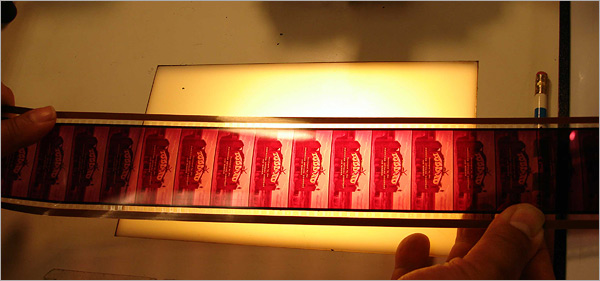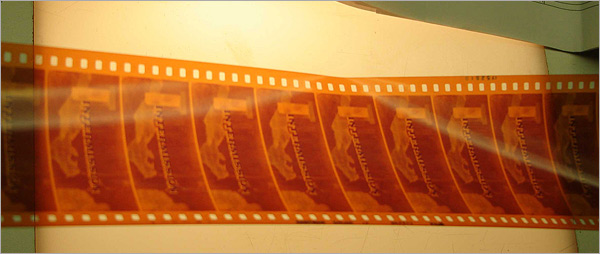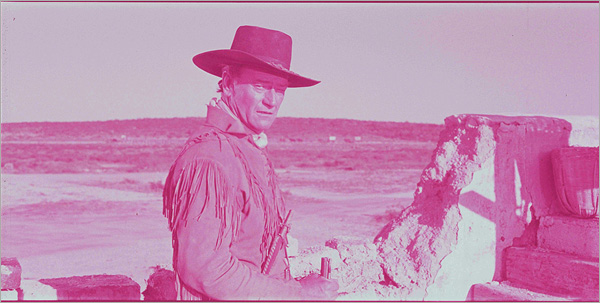 |
Site created 12/15/97.

page created: 3/20/09
 The Reconstruction and Restoration of John Wayne's THE ALAMO Robert A. Harris - Main Page |
"THE ALAMO is the greatest picture I've ever seen. It will last forever, run forever, for all peoples, all families everywhere."
- Legendary filmmaker, John Ford, 1960. 
THE ALAMO was produced as a large format 70mm (5 perf) motion picture, with an original running time of approximately 192 minutes plus Overture, Entr'acte and Exit music. It was a "special event" film distributed via Roadshow with advance ticket sales. It was nominated for seven Academy Awards including Best Picture, winning for Best Sound. Soon after its initial release in 1960, a situation arose based primarily on local transportation problems. In smaller cities, where bus service from the outlying areas was the main means of transit, the last busses were leaving before the film ended. As a result at least 30 minutes was cut from the film. As John Wayne was shooting Hatari! in Africa, the actual cutting was performed by Michael Wayne (John's son) and the film's editor, Stuart Gilmore. Because the 6 track audio could only be either cut or slightly remixed, a detailed fine cut was not an option. Those involved in the cut were led to believe that the extant 70mm prints would be trimmed and resounded, and new printing matrices produced for the 35mm release in the shorter form – but that the original negative would not be harmed or modified. That is not what occurred. The original negative and all protection elements, inclusive of the 65mm separation masters, were cut to conform to the new 161-minute length; the trims and deletions were destroyed. For over thirty years, the original Roadshow version of the film was feared lost, until in 1991 a lone surviving 70mm print was found in remarkably good condition in a film exchange in Toronto. 
Todd-AO credit from original 70mm Main Title sequence For the uninitiated, something about film elements needs to be fully understood. That print was used as the basis of what was called the Roadshow for release on laser disc. Unfortunately, it is now totally faded and suffering from vinegar syndrome, which literally turns the base of the film stock into a hard, sticky mess, rendering it unusable. While modern Eastman elements are robust with a long life expectancy, this is simply not the case for films made before the creation of Eastman 5250 color negative stock in 1961. All Eastman color stocks created before that point fade. Some more, some less, dependent upon a number of technical and storage factors, but the absolute is – they fade. On top of that, any film with an acetate base has a tendency to go "vinegar" as a result of Vinegar Syndrome (VS), another naturally occurring fact of safety film longevity. Magnetic tracks are extremely susceptible. And there is very little that a studio can do about it. It occurs even when elements are properly vaulted. What the studios do to preserve their assets is to create black & white separation masters of color negative productions. These were created of the long version, but are now cut, and after almost half a century these consummate protection elements are also showing the classic signs of early VS. The bottom line is that the condition of the original elements for this film, created in 1959-60 (the most problematic for Eastman color film stock), is a totally normal function of the dyes, chemistry and film bases involved. 
Original 65mm negative - Intermission The simple truth is that all of the extant elements have hit the end of their useful lives at the same time, and in order to preserve the film for future generations, it must be restored. The good news is that we finally have the digital mechanism that will allow us to properly restore the film to an extremely high quality end result. Now that we've had a lesson on film elements, we go to the facts. The original negative is faded, missing over 90% of its yellow layer, which controls blue and contrast, therefore yielding no true blacks and Crustacean-like facial highlights. Any attempt to pump color back into a print turns the skies a muddy green, as yellow is added. The negative also has additional damage due to improperly prepared black leader used in negative cutting, which has chemically attacked the emulsion through the two outermost dye layers. The original negative is unusable to make either prints or preservation elements. 
A frame of the original 70mm print as it exists today. The original 65mm separation masters, which would normally have served as an ultimate backup, were improperly produced and have focus issues. The Alamo audio, which had an Academy Award winning 6-track discreet mix, is not an overriding problem, although original elements have an extremely high level of vinegar syndrome. It is doubtful that the original tracks will survive through the year. The time has come for a complete restoration and overhaul – a massive undertaking. MGM and a number of vendors have been very supportive in the effort to save this epic film, and are making generous contributions. Still, in order to expedite a full and proper restoration we are seeking financial support from outside sources, both corporate and private, for the remaining 1.4 million dollars. The work involved will take about 10 to 12 months. The final result will be two versions of the film – The original Roadshow and the General Release, both with Overture, Intermission, Entr'acte and Exit Music. The most important would be the theatrical event projected fully restored in 70mm or Digital Cinema in 2K or 4K. The running time would be approximately 172 minutes, replicating the visual and aural splendor of The Alamo as it originally premiered in San Antonio on October 24, 1960, albeit in the General Release cut of the film. While the General Release cut would be available for DVD and Blu-ray, the Roadshow version of the film is intended solely for the DVD and Blu-ray home video audience. The restoration via all new Eastman film materials would guarantee that the film would survive in perpetuity. Once completed, MGM would make a restored digital cinema element or 70mm print available for special charity screenings. The print, provided in the names of major donors, with all proceeds going toward the charities involved, would include end credits containing the names of major donors, both corporate and private, which would be seen on screen and later on home video and other uses of the work, linked forever with John Wayne's The Alamo. Currently, there is no way to create a 70mm print of this film. The extant production elements are a fading 35mm interpositive and a dupe negative derived from that source – neither representing the heroic work that went into this film by John Wayne and his co-creators. One of the most important ways people know of the extraordinary gift of freedom given to Texas and our nation by those who defended The Alamo is by virtue of this film. Although an imperfect representation historically, John Wayne's work brilliantly portrays that larger than life tale, capturing the hearts and creating lasting memories for all who experience this great film. We are attempting to pull this important film back from the very brink of extinction and preserve it for generations to come. We are hopeful that once we are officially in step with the appropriate charitable organization and are able to accept contributions, that support can be found to save Mr. Wayne's epic. [4/6/09 - Editor's Note: Corporate donations toward this project ARE NOW being accepted - see details below.] Our goal is to premiere a fully restored 70mm print of the film to play in San Antonio, Dallas and other major cities on or about March 6, 2010 to benefit the continued preservation and memory of The Alamo. RAH --- Corporate Donors Can Contribute to the Alamo Restoration Effort The restoration of The Alamo will be funded via Corporate donations only. We that hope everyone who reads this column will help support this effort to return The Alamo to its full original glory. The project's charitable sponsor is now accepting contribution checks and credit cards toward the restoration of the film. All contributions are tax deductible. Contribution checks should be made out payable to... Jacob Burns Film Center, Inc. ...with the information: "f/b/o Alamo Restoration" in the memo field, normally lower left. The mailing address is: Jacob Burns Film Center 405 Manville Road Pleasantville, NY 10570 Att: Dominick Balletta Rest assured we'll keep you updated on the restoration progress here at The Bits, and you can also follow it on our official Home Theater Forum and Blu-ray.com discussion threads. Those of you who wish to contact Robert Harris can do so by sending e-mails to Bits editor Bill Hunt (billhunt@thedigitalbits.com), who will forward them on to Robert. Be sure to read Rob Siegel's new Golden Hollywood column here at The Bits on the making and original theatrical release of The Alamo as well. Thanks for your support. |

Robert A. Harris - Main Page
 |
| Site
designed for 1024 x 768 resolution, using 16M colors and .gif 89a
animation. © 1997-2015 The Digital Bits, Inc., All Rights Reserved. billhunt@thedigitalbits.com |